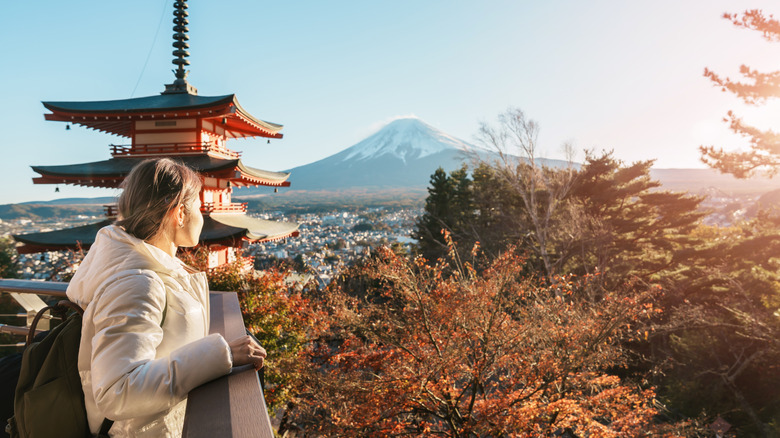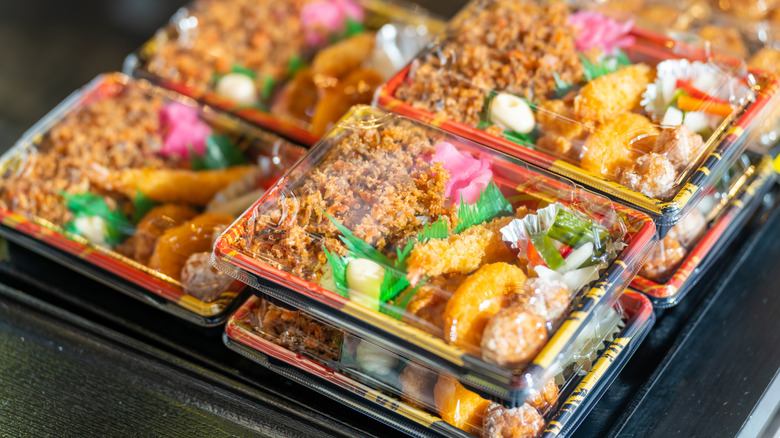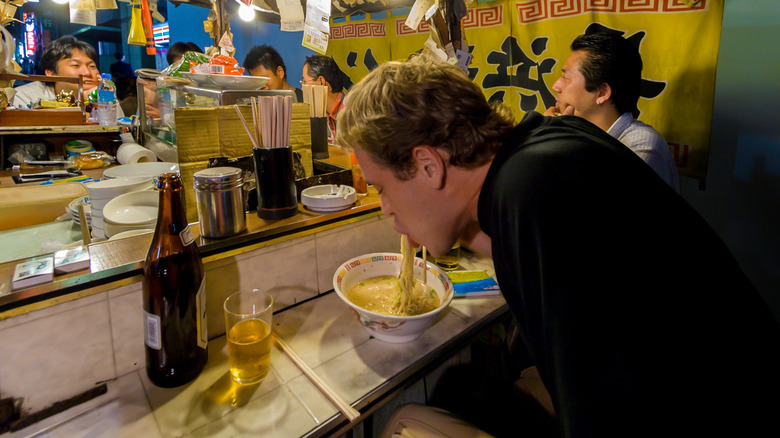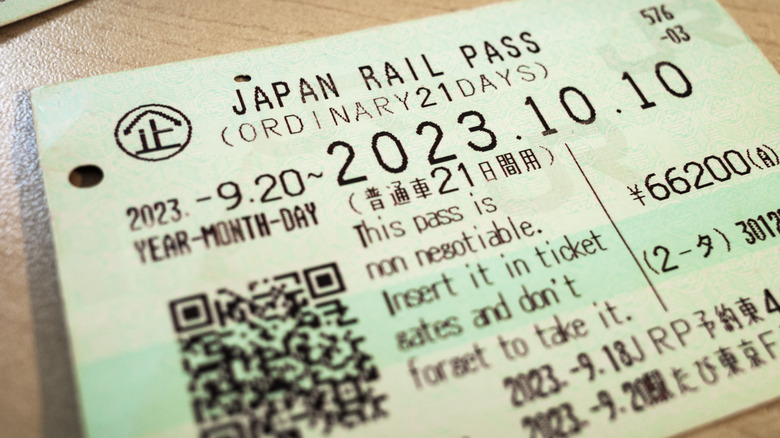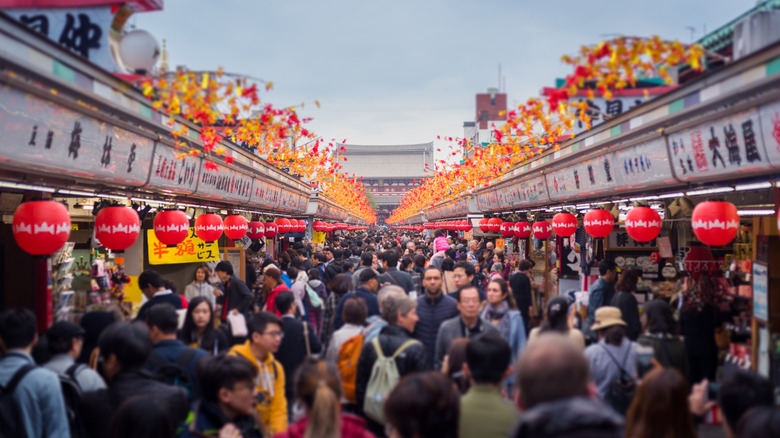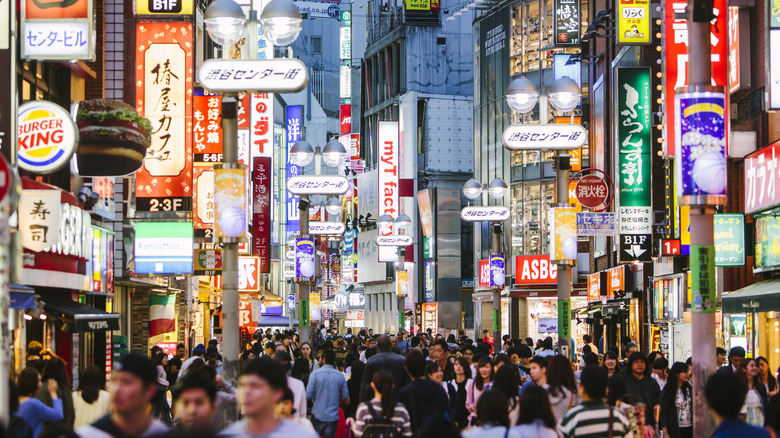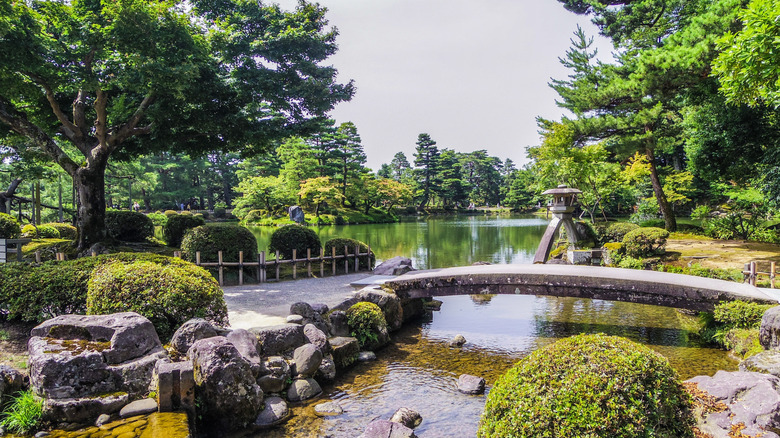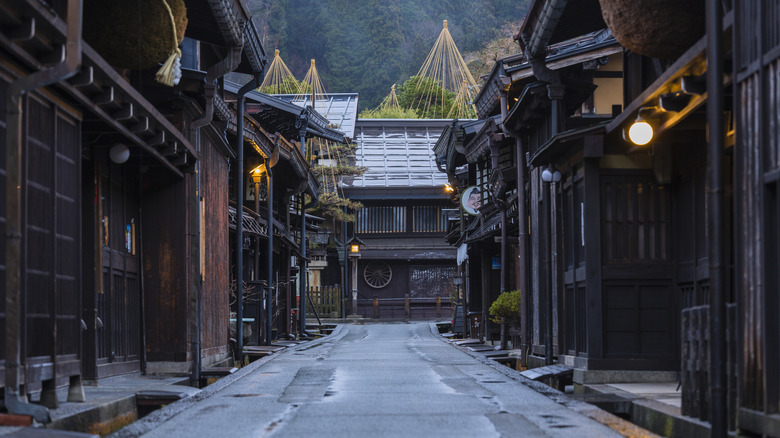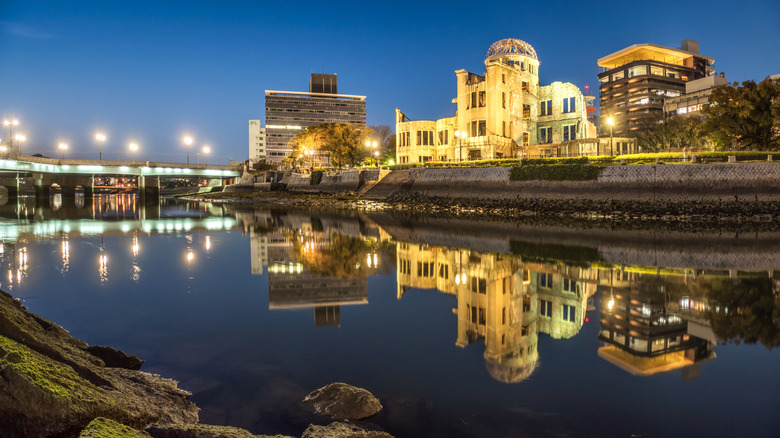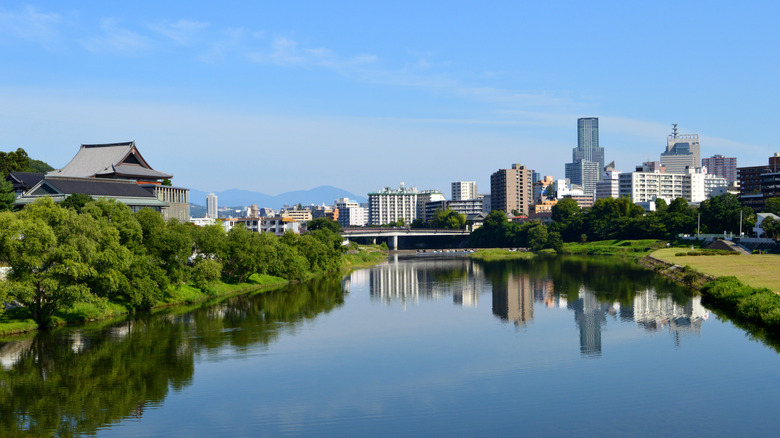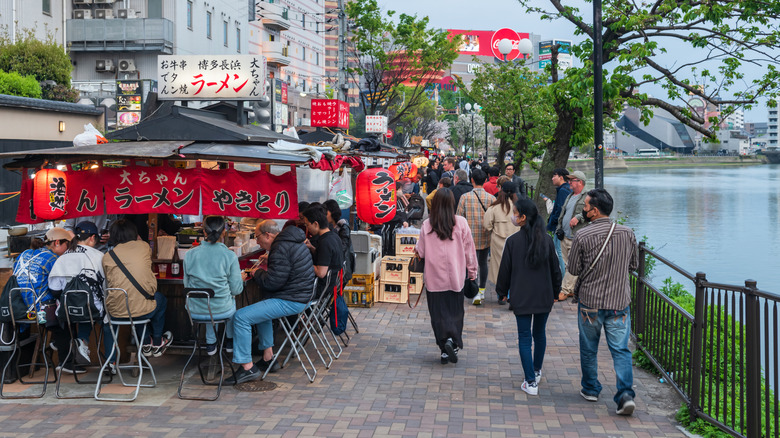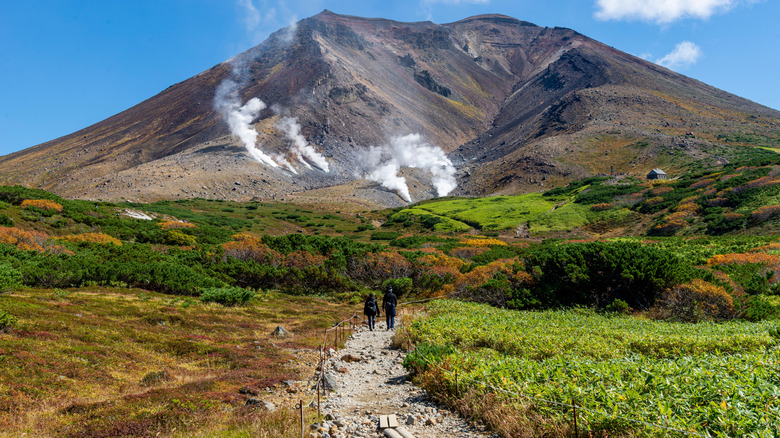8 Affordable, Gorgeous Destinations In Japan For Tourists On A Budget (Plus Tips To Save)
Planning a trip to Japan may seem daunting at first if you're on a tight budget. Not only is it extremely far, but the amount of things to do and see can seem endless thanks to the country's blend of ancient tradition, cutting-edge modernity, and world-class cuisine. However, with the right approach, visitors who aren't ready to splurge can still go all in on an unforgettable trip to this dream destination.
In fact, some of the most beautiful places in the archipelago are highly accessible to budget travel. It's just a matter of knowing a few tips and tricks, as well as narrowing your focus to key spots. To identify exactly where to go and how to travel in Japan without breaking the bank, Islands spoke with Asia travel expert Katie Woodburn-Simmonds of Simbur Travel.
First, timing is everything when it comes to experiencing Japan without shelling out wads of cash. "We love autumn/fall for visiting Japan on a budget," Woodburn-Simmonds stated. "It avoids the major Japanese holidays for domestic tourism, and has stunning colors from the trees without the price increases that can happen during cherry blossom season." She had plenty of other insights to share.
How to save money on Japanese accommodations
Where you stay is another foundational factor in keeping spending under control. There are many affordable options in Japan, and Katie Woodburn-Simmonds encourages travelers to consider renting a small camper van. Camper vans are an increasingly popular mode of travel in Japan, in part because public facilities are so abundant across the country. "There are thousands of roadside stations you can sleep at for free, use public onsens [hot springs] to shower, and you have your hotel and transport combined in one," she said.
Traveling by van offers freedom and flexibility, allowing you to explore beyond major cities at your own pace. Roads in Japan are well maintained, so you won't have any trouble getting all the way from mountain hot springs to more remote coastal towns. Other great options for budget travelers include hostels, campgrounds, and the ever-compact yet oddly cozy capsule hotels.
If you're looking for an even more unique experience, some temples in Japan offer accommodations to travelers at a good price. Also, certain manga cafes are known to offer futons in affordable private booths. This is a great option for weary travelers (and manga fans) seeking a quick, cheap rest stop -– but it isn't recommended for longer stays.
Spend less by dining in
If you have access to a kitchen, or at least a microwave, Katie Woodburn-Simmonds said dining in is another great way to save. Part of what makes Japanese food so special (and expensive) are the premium ingredients the cuisine is famous for. This includes Kobe beef, uni, puffer fish, blue fin tuna, and king crab. Getting these ingredients at the market – with the exception of the highly toxic puffer fish – and preparing them yourself will cost much less money. Plus, it'll give you the experience of living like a local. "Most supermarkets will have the same snacks and drinks as konbinis [convenience stores] but cheaper," Woodburn-Simmonds also noted.
Bento boxes are another great way to get a variety of flavors at once for less. A bento box is a Japanese-style single-portion meal — commonly rice with fish or meat with assorted side dishes — packed in a divided box for convenience and balance. Most bento boxes are meant to be microwaved, so read the packaging carefully. Locating bento box deals in Japan is something of an art. Woodburn-Simmonds recommended going to the supermarket after 9 p.m. to find discounted boxes made fresh the same day.
Take advantage of deals when dining out
There are ways to treat yourself to authentic cuisine prepared by expert Japanese chefs without hurting your wallet. To start, Katie Woodburn-Simmonds noted that Japanese chain restaurants offer excellent quality for cheap. For example, it's definitely worth checking out Yoshinoya, Coco Ichibanya, Marugame Udon, and Ippudo. And, of course, don't forget Japanese street food is extremely tasty, convenient, and affordable. Let your nose lead the way, as these aromatic food stalls often pop up near parks and temples.
Woodburn-Simmonds also shared, "Eating your largest meal at lunchtime can be a great way to save money, as many restaurants do lunch special deals, especially local restaurants near train stations." Lunchtime often offers the best value for dining, with many restaurants in business districts serving high-quality meals at lower prices to cater to local workers. Even upscale areas and fine dining establishments feature notable lunch deals, making midday the ideal time for budget-conscious food lovers to enjoy exceptional cuisine.
Getting around doesn't have to be a huge expense
Train and bus lines are bountiful, high quality, and usually very affordable in Japan. The main railway network is operated by Japan Railways Group, and it offers the Japan Rail Pass (also known as JR Pass) to tourists at a discount. Katie Woodburn-Simmonds pointed out: "While the whole JR pass is far too expensive for the budget traveler, there are regional passes that can save you a lot of money if you are exploring a lot in one region in a short period of time."
Regional passes tend to cover specific regions or entire islands of Japan. They are usually valid for between three and 10 consecutive days. Many passes are cheaper when purchased overseas online, and some of them are exclusively sold online. There are sometimes very specific restrictions that come with these passes, so be sure to dig into the fine print before making your purchase.
For travel between cities, consider taking a highway bus, suggested Woodburn-Simmonds. These buses usually travel long distances. It can be much slower than the train, but is orders of magnitude cheaper.
Look for free or nearly free activities
Many of Japan's thousands of shrines and temples are free to visit, making them an accessible way to experience the country's spiritual and cultural traditions. It's also a way to observe the fine details of Japanese architecture embedded in these ancient structures. Each site offers its own unique atmosphere.
Annual festivals are also usually free to attend, providing an immersive introduction to local culture. These events often feature colorful traditional costumes, music, and dances. Some of the parades and ceremonies date back centuries. They're a chance to learn about history, mingle with locals, and indulge in affordable street food in a lively atmosphere.
Browsing at local markets provides a cost-free way to gain a glimpse into everyday life in Japan. Seasonal produce, freshly prepared snacks, and specialty goods unique to the region are often available at a fraction of restaurant prices. Talking with vendors can also lead you to insider tips on how ingredients are used, and allow you to practice your language skills.
Japan's biggest cities can be real budget busters
When mapping out your itinerary, Katie Woodburn-Simmonds insists that it's best to avoid Japan's three major cities: Tokyo, Kyoto, and Osaka. Tokyo has a reputation as being one of the most expensive cities in the region, and, in fact, the world. It lures elite international shoppers ready to spend a pretty penny on luxury brands. "Accommodation in Tokyo is very expensive, and even if you go in with the best budget intentions, there's so much to see, eat, and do that it's easy to accidentally overspend without realizing until it's too late," she said.
Skipping these popular destinations doesn't have to make your trip any less exciting. You might be surprised to learn just how remarkable other parts of Japan are. The country is filled with lesser-known locations that are rich in culture, breathtaking landscapes, and offer far more affordable prices. Woodburn-Simmonds pointed us to a handful of these destinations that you should absolutely add to your itinerary.
1. Kanazawa
A good place to start is Kyoto's sister city, Kanazawa, located right on the Sea of Japan. It's known for its samurai clan roots, being one of the best preserved castle towns in the country, and as the home of Kenroku-en, one of the Three Great Gardens of Japan. It's the capital of Ishikawa Prefecture, and located on Japan's central island. For nearly 300 years, it was a hub of culture and commerce during the Edo period.
There are three districts from this time period that have been carefully preserved in the city's center. Castle towns in Japan were originally built around a central castle where the reigning feudal lord resided. Shops and restaurants in the historic districts tend to cater to affluent locals and visitors, but it's still possible to find a sprinkling of affordable spots along the stroll.
Kenroku-en is the city's main garden and free to explore during early visiting hours. Tickets during regular hours are also extremely cheap, at about $2. This grants you access to a sprawling 28-acre Edo-period landscape designed to embody the six attributes of a perfect garden according to Chinese garden theory: spaciousness, seclusion, artificiality, antiquity, abundant water, and broad views. It was once a private retreat for the Maeda clan samurais, and features winding paths, ponds, streams, stone lanterns like the iconic Kotoji-tōrō, and traditional tea houses.
2. Nagano City
This inland city is built around a renowned 7th century temple called Zenkō-ji. Nagano was the site of the 1998 Winter Olympics, and is a popular destination for winter sports. There's a lot of natural beauty in the area, with free to nearly free parks that are definitely worth visiting.
Zenkō-ji Temple is known as the home of one of the oldest and most sacred Buddhist images in Japan, and was brought there by an ancient kingdom. Admission to the temple will run you about $5. Regular events at the temple that are open to all at a low cost include sutra transcription sessions, drawing meditation, and dark meditation.
One guaranteed way to save money and enjoy your time in this city is to get outside. Some of the northeast sections are part of Myoko-Togakushi Grenzan National Park, a rugged volcanic mountain range. The best way to access the park is to travel to the once ancient village of Togkaushi, accessible from Nagano's city center via a one hour bus ride. In Togkaushi, you can find many scenic hiking paths, affordable campgrounds (about $15 per night for 2 person tent), and historical sites. Be sure to grab a bowl of the area's famous soba noodles, and find your way through a maze at the Togakushi Ninja Center (admission is about $5) where ninjas once trained.
3. Niigata City
This gorgeous port city is the capital of a prefecture in western Japan known as an agricultural and culinary powerhouse –- it is the largest producer of rice in Japan. The climate along with centuries of tradition come together to produce rice, sake, and hegisoba noodles, prized near and far for their unique regional flavors. And, since it sits by the sea of Japan, there's bountiful fresh seafood to boot.
There are many casual options that are serving up local delicacies. Head over to Niigata Station, the main railway stop in the center of town, for a solid selection of casual eateries. Also note, the Imayotsukasa Sake Brewery offers free daily tours in its 120-year-old building, which includes free sake tastings. If you're a fan of rice cakes, you will find much joy at Rice Cracker Kingdom, where you can learn about the process of making these sweet treats and even fry your own for about $3 each.
After eating to your heart's content, why not take a stroll in the beautiful Yahiko Park, with free admission? This spot is the perfect place to take in the changing of the leaves in fall. For an extra treat, get up close and personal with the more than 600 species of fish at the Niigata Aquarium's marine tunnel. Admission is about $10.
4. Takayama
If you're looking for historic, small town charm, add Takayama to your itinerary. It's a real gem — without the high price tag — tucked away within the heart of the Japanese Alps. Most of the main attractions are all within walking distance, which means you won't be spending much on getting around.
The Miyagawa Morning Market, one of the largest morning markets in Japan, is a great place to not only learn about local cuisine, but also take in the beautiful Miyagawa River running through town. You might try to find a deal on one of the local, prize-winning delicacies: Hida beef. Wander through the well preserved Sanmachi Historic District, where the area's famous woodworking skills that go back over a millennia are on full display.
Takayama is also known for its fall festival, held across two days every October. It features a procession of more than 10 massive floats decorated with lanterns and followed by people dressed in traditional garb. The ornately carved wooden floats are adorned with centuries-old, hand-operated robot puppets that perform intricate routines.
5. Hiroshima
At this historic destination, you'll find many sites dedicated to the legacy of the atomic bomb, most of which are either free or very affordable. For example, the Hiroshima Peace Museum and the Atomic Bomb Dome are free to all. In the museum, visitors will encounter deeply moving exhibits including victims' personal artefacts and powerful photographs and survivor drawings. Historical narratives about Hiroshima before and after the bombing, as well as global efforts towards peace, offer visitors context for the atrocity and opportunities for reflection. Outside, the dome is the only structure that was left standing in the area after the first bomb dropped, and today is an UNESCO world heritage site.
After visiting these memorials, it might do you some good to have a peaceful environment for introspection. Take the ferry (free with a JR pass) or train over to the mystical nearby inlet of Miyajima Island. It takes about an hour to get there. There are a few cultural sites of interest on the islands, such as the iconic Torii gate, Daisho-in Temple, and the Senjokaku Pavilion. In addition, there is a splendid forest on the island, with a handful of hiking trails of varying lengths and difficulty for all levels to enjoy. Deer are everywhere on the island, making it a real natural wonder.
6. Sendai
In the northeast, along the Sendai Bay, you'll find one of the largest yet still affordable cities to visit in Japan. There's a ton to see. Luckily, the main sites of interest are all accessible by bus, and an all-day pass costs only about $3.
Soak up local lore and panoramic city views at the Aoba Castle. There you'll learn about the legendary Lord Date Masamune, who founded the city in the 17th century. Dedicated to excellence in battle, as well as fashion, he had the nickname One-Eyed-Dragon and precipitated a term for a fashionable and heroic young man, "date otoko." His legend persists throughout Japanese pop culture, including his legendary armor which can sometimes be seen on display at the Sendai City Museum of History and Folklore. Admission is $3.
Every October, Sendai transforms into a magnificent stage for 150 dance troupes from around the country who compete in the colorful Michinoku Yosakoi Festival. Competitors don vibrant and flowing kimono-like costumes, while they chant, clap (using traditional wooden naruko), and dance across stages throughout the city on the first day. On the second day, there's a parade.
7. Fukuoka City
There are about 100 stalls to choose from across Fukuoka City to get your fill on classics and regional specialties. It also happens to be known as Japan's friendliest city. Every night at around 6 p.m. you'll see these stalls and the city night life in the streets come to life. Note that many vendors only accept cash, so be sure to have some on hand. A typical dish at a Fukuoka yatai costs around $7, making it affordable to sample and hop between stalls.
Fukuoka is another of Japan's ancient castle towns, with many of its ruins offering visitors a window into its history. Maizuru Park is free to access, and contains ruins of the 17th-century Fukuoka Castle, which when first built had 10 gates and 47 turrets (only one original turret survives today). If you're looking to get fully immersed in the experience, for about $14 you can get fitted for a kimono and wear it around the castle grounds for an hour.
The Hakata Machiya Folk Museum ($2 admission) displays daily life in the Meiji and Taishō eras. Visitors can try their hand at traditional Japanese arts such as origami and calligraphy, guided by expert artisans. It's a hands-on way to engage with centuries-old craft techniques.
8. Hokkaido
If your style of travel involves getting out into nature, this island is an excellent choice. A popular destination for the trekking-inclined is the volcano of Mount Asahi. It offers stunning views, emerald green-blue ponds, and billowing steam vents from deep beneath the earth's crust. There's a funicular that will take you straight to the top, but a round trip pass is pricey. Best to take in the sights, sounds, and smells by way of the many hiking trails on the mountain. Campgrounds in the area offer highly affordable nightly accommodations.
The Sapporo Snow Festival is a cozy winter celebration held each February, in Hokkaido's capital city of Sapporo. It is a magical time to visit. Stroll through Odori Park to see enormous snow and ice sculptures, some illuminated with immersive projection mapping at night. The festival also features outstanding performance lineups, and food stalls with treats that will warm you right up.
If you can find one, it's worth staying at a hotel with hot spring baths. There are dozens of them in this area, some of which are accessibly priced. For example, the Adex Inn is a good option. It's the sister property to Dai-ichi Takimotokan ryokan just next door. Guests at Adex Inn can access the neighboring property's Grand Bath without paying ryokan pricing.
